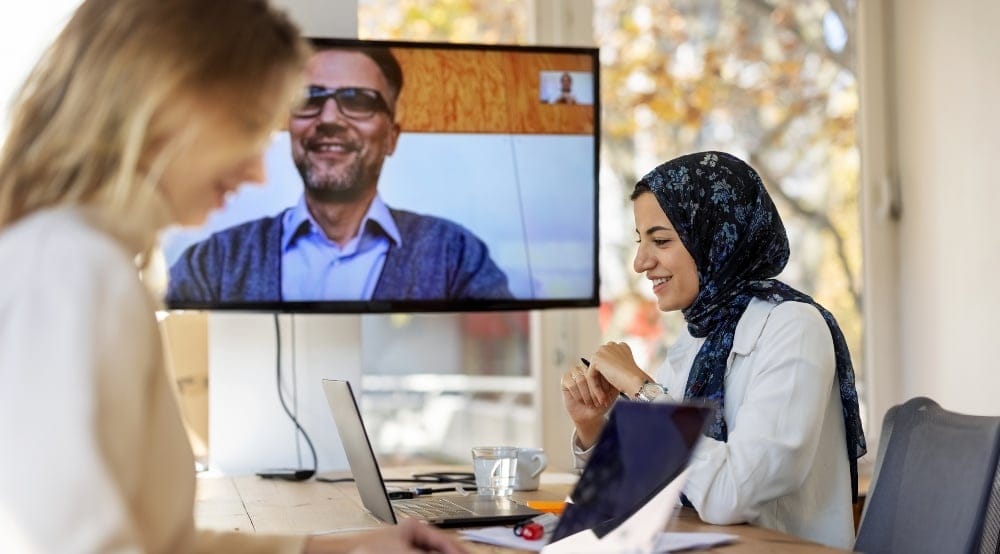
Let us help you with finding an office space
Our experts are here to help take the hard work out of finding your next office space.

The new era of hybrid working is here to stay, with 85% of employees saying they want a combination of working from home and the office. This model combines the flexibility of remote work with the option to enjoy face to face collaboration and superior office facilities.
As management consultancy McKinsey summarises, “Many companies are planning a hybrid virtual model in which some employees are on-premises, while others work from home. The new model promises greater access to talent, increased productivity for individuals and small teams, lower costs, more individual flexibility, and improved employee experiences.”
However, to ensure that teams benefit from this new working paradigm, the office itself must change – especially when it comes to meeting spaces.
 A room with a table isn’t enough to accommodate new ways of working.
A room with a table isn’t enough to accommodate new ways of working.
Get your monthly dose of workplace insights, productivity hacks and business leadership ideas - delivered straight to your inbox.
In the past, all a meeting room required was a table, adequate lighting, some comfortable chairs, and perhaps a screen or projector. But the meteoric rise of video conferencing technology from Zoom and Microsoft Teams and hybrid working habits have transformed the meeting experience.
As research suggests, a third of meetings will now be hybrid. That means that meeting rooms must not only be comfortable and accessible for those physically present, but also deliver an equally engaging experience for those joining remotely using audio and video.
Recently, Microsoft published its hybrid meeting room strategy, featuring curved desks and eye-level cameras. Satya Nadella, Microsoft’s CEO, explained, “We want to ensure those joining remotely are always first-class participants.”
Echoing this, Tim Oldman, CEO of the productivity thinktank Leesman, warns, “employees will expect their employers to make meaningful changes to the office environment that reflect their newly learned workstyle. Inaction from employers now would be hugely harmful.”
So, how can modern meeting rooms offer an equal playing field for both in-person and virtual attendees? And what should businesses look for when seeking a state-of-the-art workspace?
Connective and immersive technology is vital. As Forrester highlights, “hybrid work will put new stresses on your tech infrastructure. You must have the ability to maintain at-work and work-from-home tech at robust levels. This will be a new business requirement.”
What does this technology look like? Harvard Business Review (HBR) explains that hybrid-ready meeting rooms must incorporate high-quality video conferencing hardware, next-generation responsive cameras, high-quality microphones and speakers, and interactive wireless displays, alongside high-speed internet.
This is very different from the audio conferencing of the past. Once, a conference phone would produce lo-fi audio, inevitably leading to participants talking over one another. With this new technology, in-person attendees and remote workers will be able to see each other on screens. They will be able to use content sharing and follow the same presentation deck too. This ensures that everyone is on the same page – or rather, slide.
 Organisations are investing in new kinds of technology-enabled spaces.
Organisations are investing in new kinds of technology-enabled spaces.
Not only do meeting rooms now require future-fit video conferencing technologies, but they also need the supporting infrastructure to ensure a smooth experience. Meeting rooms should be underpinned by on-demand availability and easy booking systems.
Individual room temperature controls and a fresh air supply are especially important for occupant comfort. There’s nothing worse than a stuffy, airless meeting room – and with the right tools, employees will have control over their environment. This level of personalisation is increasingly being expected.
With 66% of business decision-makers considering redesigning physical spaces to accommodate flexible work environments, keeping up with new office demands requires significant investment. For example, Google is spending £730m to reinvigorate its post-Covid offices, an investment that includes inclusive meeting rooms for hybrid working.
Coming out of a challenging two years, not all organisations will have the resources to reconfigure meeting spaces from the ground up. After all, the creation of successful hybrid spaces isn’t just about purchasing hardware. It is also about redesigning spaces and ensuring the quality and consistency of supporting infrastructure and services. For that reason, many businesses are considering their next office move.
Businesses are adjusting their office strategy to respond to changing working patterns, which sees the office take on a new role in our working lives. This includes seeking modern spaces ready to accommodate hybrid working. Such offices are ‘ready-to-go', are always staffed, and help employees understand the benefits of hybrid working, wherever they are located.
One provider that has upgraded its meeting spaces is Pavilion Club, which offers members luxury workspaces along with a range of other facilities across three London locations. Since the pandemic, video conferencing technology has become an essential for its members. The systems in place offer freedom and flexibility – any device can easily be connected for hybrid meetings. What’s more, these meeting rooms double as private dining spaces; the Knightsbridge Club even boasts food from renowned chef Tom Kerridge’s restaurant and bar.
 Pavilion Club, Knightsbridge
Pavilion Club, Knightsbridge
Meanwhile, Uncommon, a wellbeing-focused provider, has refitted its meeting rooms with new technologies to enable a seamless meeting experience for every attendee. Uncommon meeting spaces employ the latest ClickShare technology, which makes it easy for remote attendees to dial in and feel as if they are in the room with their fellow attendees.
 Uncommon Liverpool Street
Uncommon Liverpool Street
TOG (The Office Group) has found that its meeting spaces are being used in new ways since the pandemic. It has seen increased recurring space bookings, which teams use to work collaboratively throughout the day – rather than simply having a single, discrete meeting. In response, TOG is reconfiguring what its meeting spaces offer, with features such as soft seating and break-out areas for more informal work, alongside video conferencing technology as standard.
 The Office Group, 19 Eastbourne Terrace
The Office Group, 19 Eastbourne Terrace
The good news is that major cities like London are brimming with flexible office spaces, whether your preference is considered luxury or verdant wellbeing. From Holborn to Shoreditch, there are a range of workplaces available for businesses of all sizes.
Ready to explore future-fit office options for your teams? Knight Frank can assist you with your search.

Our experts are here to help take the hard work out of finding your next office space.